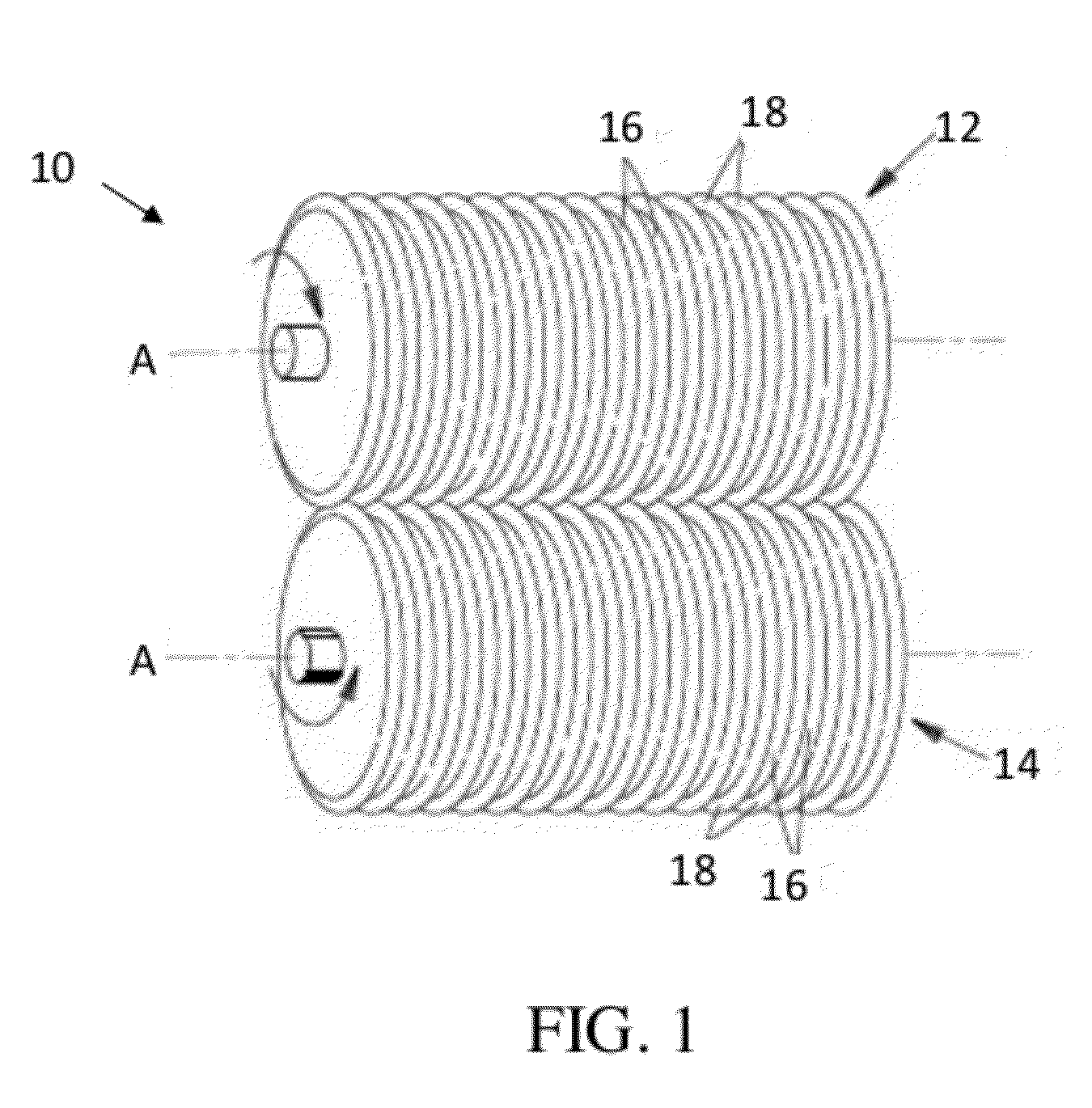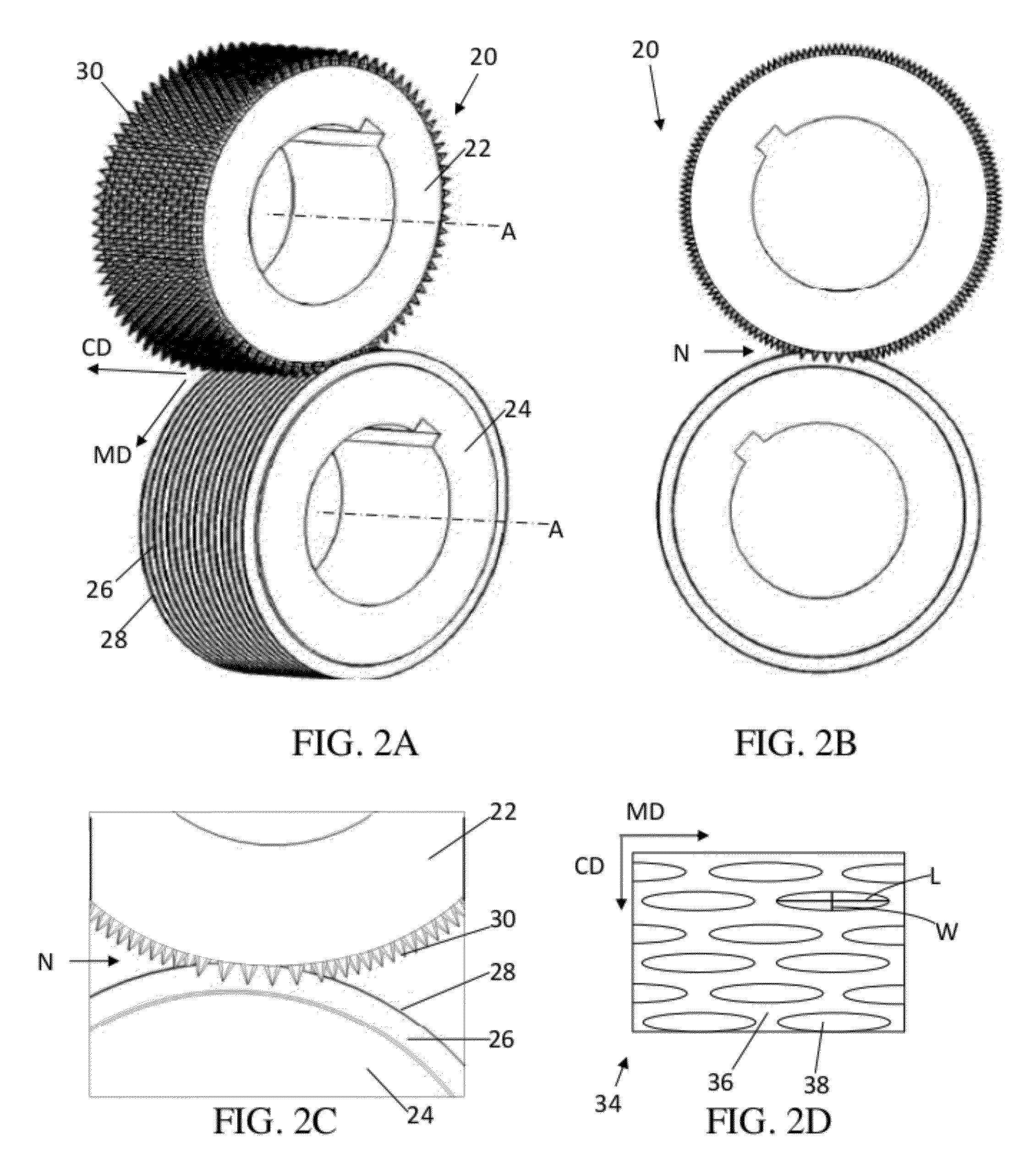Apparatus and process for aperturing and stretching a web
a technology of apertures and webs, applied in the direction of dough shaping, manufacturing tools, buttons, etc., can solve the problems of reducing the thickness of some individual fibers, prior art approaches are not suitable for creating webs, and the dimensions of the cross-machine direction of apertures are not wider than the width of the web,
- Summary
- Abstract
- Description
- Claims
- Application Information
AI Technical Summary
Problems solved by technology
Method used
Image
Examples
example 1
[0105]In one non-limiting example for making apertures in a polymer film, like the web 300 shown in FIG. 17 (comprising micro-apertures 312 and macro-apertures 314), an apparatus can be used that comprises a 1.5 mm pitch raised ridge RKA roll intermeshed with a 1.5 mm pitch ring roll at 3.8 mm depth of engagement. The raised ridge RKA roll has teeth that are oriented so the long direction runs in the MD. The teeth are arranged in a staggered pattern as shown in FIG. 5A. The teeth have a pyramidal shape with 6 sides that taper from the base to a sharp point at the tip, and have a height ht of 4.7 mm. The teeth have an included angle (α from FIG. 5B) of 62 degrees, a side wall angle on the long side of the tooth of about 6 degrees (β from FIG. 5C), and an end facet included angle of 90 degrees (γ from FIG. 5E). The ridges that span between the teeth on the RKA roll are non-radiused and form a flat surface. The teeth are finished at the ridge in a semi-truncated format as shown in FIG....
example 2
[0110]In one non-limiting example for making a corrugated web having apertures in the grooves, an apparatus can be used that comprises a 2.0 mm pitch raised ridge RKA roll intermeshed with a 2.0 mm pitch ring roll at 6.3 mm depth of engagement. The raised ridge RKA roll has teeth that are oriented so the long direction runs in the MD, and the ridges and grooves extend circumferentially around the ring roll. The teeth are arranged in a staggered pattern as shown in FIG. 5A. The teeth have a pyramidal shape with 4 sides that taper from the base to a sharp point at the tip, and have a height ht of 6.9 mm. The teeth have an included angle (α from FIG. 5B) of 57 degrees and a side wall angle on the long side of the tooth of about 5 degrees (β from FIG. 5C). The ridges that span between the teeth on the RKA roll are not rounded and form a flat surface. The teeth are finished at the ridge in the non-truncated format as shown in FIG. 6C. The teeth have an MD tooth spacing SMD tip to tip of ...
PUM
| Property | Measurement | Unit |
|---|---|---|
| depth of engagement | aaaaa | aaaaa |
| depth | aaaaa | aaaaa |
| distance | aaaaa | aaaaa |
Abstract
Description
Claims
Application Information
 Login to View More
Login to View More - R&D
- Intellectual Property
- Life Sciences
- Materials
- Tech Scout
- Unparalleled Data Quality
- Higher Quality Content
- 60% Fewer Hallucinations
Browse by: Latest US Patents, China's latest patents, Technical Efficacy Thesaurus, Application Domain, Technology Topic, Popular Technical Reports.
© 2025 PatSnap. All rights reserved.Legal|Privacy policy|Modern Slavery Act Transparency Statement|Sitemap|About US| Contact US: help@patsnap.com



